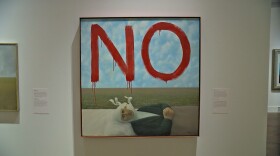February is Museum Month in San Diego. Museum Month started 39 years ago to make museums more accessible and more affordable for locals and visitors alike. All participating museums and cultural institutions across San Diego county are offering half-off admission for the next 28 days.
“Go to any library, pick up your museum pass — you can see a list of all the museums right there," San Diego Museum Council executive director Bob Lehman.
This year, there are more than 60 participating museums, with 15 new locations. One of newest museums participating in Museum Month is The Brain Observatory.
The Brain Observatory is located on Broadway, right across the street from Santa Fe Depot in in Downtown San Diego. It's the "brainchild" of Jacopo Annese.
For most of his career, Annese was a professor in residence at UC San Diego, along with being the president and CEO of the Institute for Brain and Society.
Annese said the goal behind the combination of brain research lab and art gallery was to bring brain and society closer together.
“I felt like I was in the university setting working behind closed doors, and I personally felt there was a lot of beauty and mystique in the work that we were doing because we work with real brains," said Annese.
The Observatory just opened, and Annese said it’s still a work-in-progress. But several brains are already here — brains donated by people whose life stories are well known to Annese.
“(They were) donated by people who had maybe a diagnosis of Alzheimer’s disease — Parkinson’s. My specialty is brain imaging," Annese said.

He said most imaging work is an attempt to understand the characteristics of disease, how it manifests and how it progresses. But that work is typically done by researchers who don’t have any idea about the details of a brain donor’s life.
Annese said putting those images together with a person’s life story can lead to a clearer picture of the disease and perhaps, one day, to a cure.
But at this point, you might be asking yourself, what exactly is the connection between brains and art?
“There’s two kinds of art when it comes to brains. There is so-called neural art, which is making art out of brain images, which we have on our north wall," Annese said. "And then there is the imagining. Going from imaging to imagining, that’s what artists do, using introspection, using imagination, and I think that there is a potential in asking artists to team up with scientists to discover how the brain works ... and it’s very possible that if you don’t make artists feel like intruders in your lab, they could actually contribute with insight."
In the near future, Annese said, you’ll be able to watch researchers doing work on brains, while at the same time, seeing art informed by their work.

To visit the Brain Observatory or any of the 59 other museums participating in Museum Month, you can download a digital pass good for up to four people at the San Diego Museum Council's website. Or, you can scan a QR code on the paper passes available at more than 80 libraries throughout the county.





